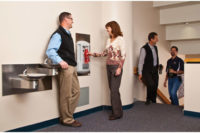There are four remaining state-written plumbing codes used in the United States. You could say that the remaining four states are just stubborn. Maybe they think they do it better than the model plumbing codes, but they don’t.
All of the other states use one of the model plumbing codes. If you do the math, the Uniform Plumbing Code and International Plumbing Code are used in 45 states in our country. The one remaining anomaly is New Jersey, which adopts the National Standard Plumbing Code, hence, 46 remaining states on model codes. Illinois, one of the four states with its own plumbing code, created shock waves this past month by announcing some of the proposed changes to its state plumbing code.
Unlike the model plumbing codes, it can propose changes without providing any reason or justification for said changes. If you tried that with a model plumbing code, your code change would not be accepted. Every code change to the model plumbing codes must be technically substantiated.
Perhaps the most controversial change proposed by Illinois is to mandate that hot water has a minimum temperature of 160° F. You read that correctly, 160° F. The change then goes on to state that this is the minimum temperature, even in recirculating lines.
While they were at it, the changes propose to remove ASSE 1017 as an acceptable valve. They also propose to prohibit mixed temperature water, tempered water or any other water other than cold water. The definition of cold water is proposed to be water that is ambient temperature. I don’t think they understand what the word ambient means. Ambient means in the immediate surroundings. Thus, ambient temperatures indoors normally range from 68° to 78°. I prefer my cold water colder than those temperatures.
You may be asking, “Who was the brilliant mind that came up with such a dumb provision of 160° hot water?” I wondered the same thing. However, no one knows because the changes are simply printed in the Illinois Register as coming from the Department of Health. The Department of Health did add a few lines to justify about 100 pages of proposed changes. It states, “This rulemaking addresses public health concerns associated with waterborne opportunistic pathogens (such as Legionella) and hazardous substances (such as lead) in potable water systems…”
Apparently, someone thinks that if you make the hot water temperature 160° for all hot water, you do away with waterborne opportunistic pathogens. In the meantime, they will start scalding people to death. You would think that a Department of Health would understand the extreme dangers of hot water.
Water at 160° contacting the skin results in second degree burns instantly. That has been a known fact since the 1940s. A third-degree burn results after only one second of contact. The scald time/temperature table is readily available for anyone to review.
You may be asking how Illinois plans to prevent scalding. The plumbing code requires shower valves and public lavatories to be protected with an ASSE 1016 or 1070 valve for showers and an ASSE 1070 valve for lavatories. There is no protection required for bathtub fillers. Imagine someone falling into a tub of 160° F water in a bathtub. They would die almost instantly. Bidets are also not required to have any protection.
When you read the new proposed requirements, at first you would think that this higher water temperature does not apply to residential buildings. It states, “In buildings other than residential, hot water shall be generated, distributed and maintained at 160 degrees Fahrenheit or higher.” However, in later sections, it requires all plumbing fixtures to have hot and cold water, including fixtures within residential buildings. The definition of hot water states a minimum temperature of 160° F. Hence, turning on a lavatory or bathtub in a home could result in 160° or hotter water discharging. Imagine the increased scalding incidents.
How hot is too hot? Distributing water throughout a building at 160° is too hot and very dangerous. The model plumbing codes have it correct. With a recent change, all the model plumbing codes now agree that the definition of hot water is water at or above 120°. Hence, most hot water is distributed at temperatures well below 160°.
The other wacky provision in the Illinois proposed changes include the elimination of all lead from the code, including lead pans, lead flashing and caulked joints. Seeing the removal of caulked joints felt like an attack on the entire plumbing profession. For some reason, a castiron caulked joint is a part of plumbing history. In the city of Chicago, it is still the only way for cast iron to be joined.
One last crazy provision is the removal of galvanized steel pipe as an acceptable piping material for both water and drainage. This made me think of all the high-rise buildings in Chicago with large-diameter galvanized steel pipe water risers. There are also many drainage connections for 2-inch and smaller drainage pipes connected to cast-iron soil pipe.
If you are wondering how this will impact the city of Chicago and its mandate for leaded caulked joints for all cast-iron soil pipe, it won’t. Illinois has a knack for adopting laws that provide an out for any jurisdiction having a population above 500,000. Well, there is only one city in Illinois with a population above 500,000; that city is called Chicago.
Interestingly, Chicago uses the International Plumbing Code as their base document and then adds in the Chicago amendments. So, while the State of Illinois continues to write a state plumbing code, Chicago follows one of the model plumbing codes.
The latest proposed amendments to the State of Illinois Plumbing Code prove, once again, why the four remaining states, including Illinois, should switch to adopting either the International Plumbing Code or Uniform Plumbing Code. The model plumbing codes do not allow one, or more, wacky ideas to be added to the plumbing code based on one person’s opinion.
The consensus or governmental consensus process prevents this kind of craziness to creep into the code. The open process requires technical substantiation that should have been used in Illinois. Perhaps the new governor in Illinois will see the light and move to a model plumbing code. The other three states should also see the light and adopt a model plumbing code. The era of state-written plumbing codes needs to come to a complete end.





